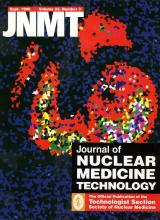Abstract
Objective: Proper alignment of the transmission and emission images in PET is crucial for appropriate attenuation correction and other uses, such as registration of the PET emission data with data from another modality. The patient may be removed from the table after the transmission scan and later repositioned for the emission scan using a laser beam projected onto fiducial marks on the patient. Repositioning the patient introduces the possibility of misalignment between the transmission and emission scans. The purpose of this investigation was to determine the magnitude of any transmission-emission scan misalignment.
Methods: An immediate postemission transmission scan was obtained on 17 patients. The usual preinjection transmission image was registered to the postemission transmission image using a surface-matching algorithm. The rotations and translations necessary to register the two data sets are a measure of patient repositioning error.
Results: The average X, Y and Z translations were 2.32 mm (range 0.54–4.66 mm), 1.35 mm (0.11–4.33 mm) and 4.6 mm (0.66–16.61 mm), respectively. The average X, Y and Z rotations were 1.32° (0.07–4.79°), 0.84° (0.10–2.12°) and 2.67° (0.01–13.03°), respectively.
Conclusion: We conclude that while our transmission and emission data are generally repositioned within acceptable limits for the purpose of attenuation correction, significant errors are most likely to occur in the Z axis repositioning.







